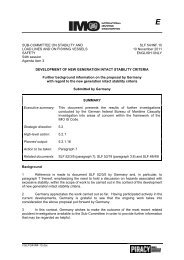Examination of the intact stability and the seakeeping behaviour
Examination of the intact stability and the seakeeping behaviour
Examination of the intact stability and the seakeeping behaviour
You also want an ePaper? Increase the reach of your titles
YUMPU automatically turns print PDFs into web optimized ePapers that Google loves.
6 Detailed examination<br />
in tables 6.7 <strong>and</strong> 6.9, are a higher displacement <strong>and</strong> <strong>the</strong>refore a higher draft <strong>of</strong> about 1.6 m<br />
for <strong>the</strong> second loading condition set. For a vessel <strong>of</strong> this size, <strong>the</strong>se dierences do not seem<br />
remarkable. Never<strong>the</strong>less for one <strong>of</strong> <strong>the</strong> rst loading conditions, a moderate maximum transversal<br />
acceleration <strong>of</strong> 5.5 m /s 2 occurs, while for one <strong>of</strong> <strong>the</strong> second loading conditions, <strong>the</strong> value becomes<br />
signicantly higher, reaching an extremum <strong>of</strong> 10 m /s 2 . These maximum accelerations occur for a<br />
GM solid<br />
∼ = 9.25 m in both cases.<br />
The analysis reveals that signicantly dierent accelerations may occur for similar GM values<br />
<strong>and</strong> just slightly dierent oating conditions. Thus a simple way to decrease <strong>the</strong> risk <strong>of</strong> accidents,<br />
like <strong>the</strong> determination <strong>of</strong> a single upper limit for <strong>the</strong> GM for example, to limit <strong>the</strong> excessive<br />
<strong>stability</strong> <strong>and</strong> decrease <strong>the</strong> occurring transversal accelerations is not a feasible approach.<br />
56

















